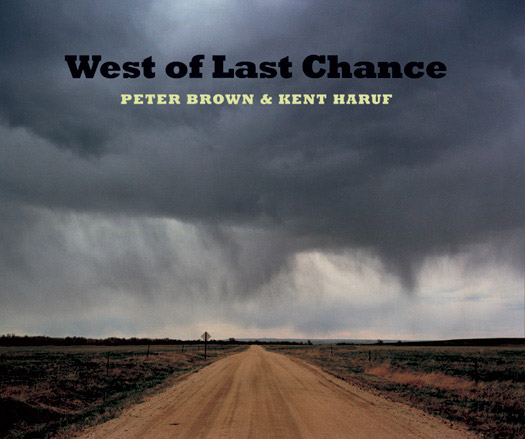Review (of sorts): West of Last Chance by Peter Brown and Kent Haruf

I’ve lived in the US for about ten years now, so I’m now very familiar with many things that, when I first came here, surprised me or that I found unusual. But ten years are still a short period of time, compared with the thirty years I had lived in Germany before. What is more, those thirty years included the most formative periods of my life, which, I suppose, will mean that I will always see things if not exclusive from a German perspective, then at least with a German component. It’s not a bad position to be in actually, amazement (along with the occasional exasperation) is still a big part of my American life. Some things are just very familiar, yet still a bit alien to me. I should add that I have developed the same approach (if that’s the word) towards Germany now, which certainly makes for “interesting” visits back “home.”
There are lots of things that still amaze me about the country I’m living in, ranging from the mundane - for example the fact that American sports fans are completely obsessed with completely meaningless statistics (Germans are crazy about soccer, but asking a German soccer fan about anything beyond the number of some team’s or striker’s goals will typically only result in a bewildered stare) or that some American microbreweries produce fantastic beer - to the more fundamental. One of those very fundamental things is the idea that there exists, for example, a “true” American West.
In fact, the idea that there is a “true” or “real” something as opposed to a fake one is one of those narratives I see a lot. Another example would be that small-town America somehow represents the “real”/”true” America - unlike the America on view in big cities. My gut feeling is that the German equivalent for all of this would be what is contained in the concept of Heimat. Heimat means, well, “home” or “homeland”, except that Heimat means infinitely more. If you want to translate the German word Heimat, it has the same emotional contents as, say, the American West. There’s a lot of cultural value, on top of a huge layer of emotions, with an assorted bunch of myths added to the mix; and the more you try to explain things, the further you get away from achieving your goal of making things clear.
It might not be such a coincidence that I became very interested in photography right after I moved to the US. Photography itself has a lot of things in common with concepts like the American West or Heimat: Just below the surface of the obvious, there is a lot of cultural and emotional contents in photography, which makes it a fantastic medium for artists to create deceptively simple pieces of art. Onto these pieces of art the viewer can… no: will then project her or his own sentiments. That, for me, is the experience of photography. (If art critics don’t get this, who cares?)
Seen in this light, it might become more obvious why photography dealing with, for example, the American West can become such dangerous territory. For photography to be able to work, you need to approach it with an open heart and mind. But the American West or Heimat or other such concepts typically are such loaded topics that it is hard to see them treated in a way other than, well, what is supposed to be the right one. What this means is here we usually see the most vehement opinions about work, with - typically - the insiders (if I may use that word) praising photography that shows what they want to see and condemning the one that doesn’t, and outsiders often sticking with stereotypes. It is rare to find work that transcends these kinds of problems. When you find it, you really know.
West of Last Chance by photographer Peter Brown and writer Kent Haruf is a portrait of the Great Plains. You could treat it as a photography book with writing, but that’s really not what you want to do. West of Last Chance is a collaboration between a photographer and a writer.
Most of the writing seems be as barren as the landscapes it is often placed next to, but once you let the words and images settle in, once you give yourself some time to explore what the casual viewer might find “boring,” you get to discover something. With my slightly rambling introduction I’ve clearly already established myself as a bad writer, so to continue in this vein: What you discover I can’t say. If I tried to explain it I’d do exactly what I explained earlier can only lead you astray: Trying to define the true meaning of Heimat, say.
In the words of Haruf, the Great Plains are a country that “isn’t pretty, but it’s beautiful.” Some understatement!
So you’ll have to look and discover for yourself. West of Last Chance is like literature. Just like you can’t expect to be able to read a three-hundred page novel in ten minutes, you can’t expect to get what the book as about by looking at all the photographs in one setting. I complained a little while ago that so many photo books are like gallery shows on paper; West of Last Chance clearly isn’t. Instead, it’s a book that I’m finding more and more meaning in. Recommended.
West of Last Chance, photography by Peter Brown, writing by Kent Haruf, 256 pages, W. W. Norton & Company, 2008